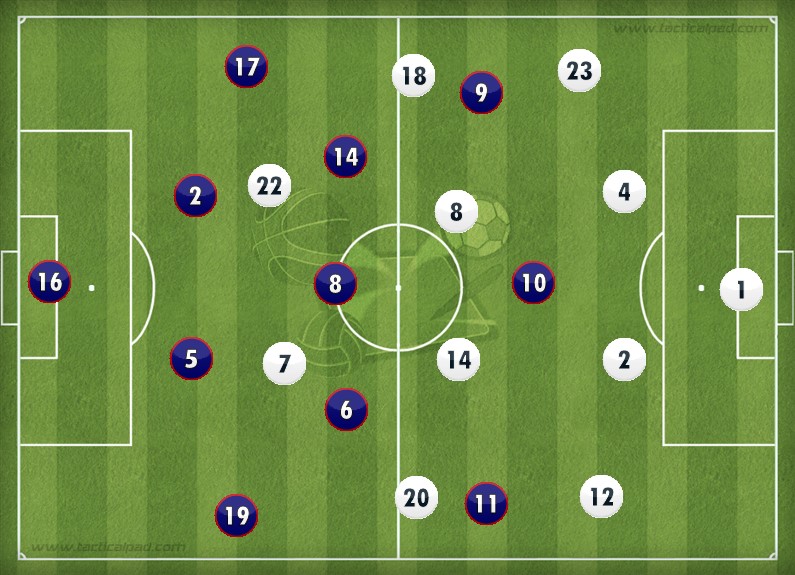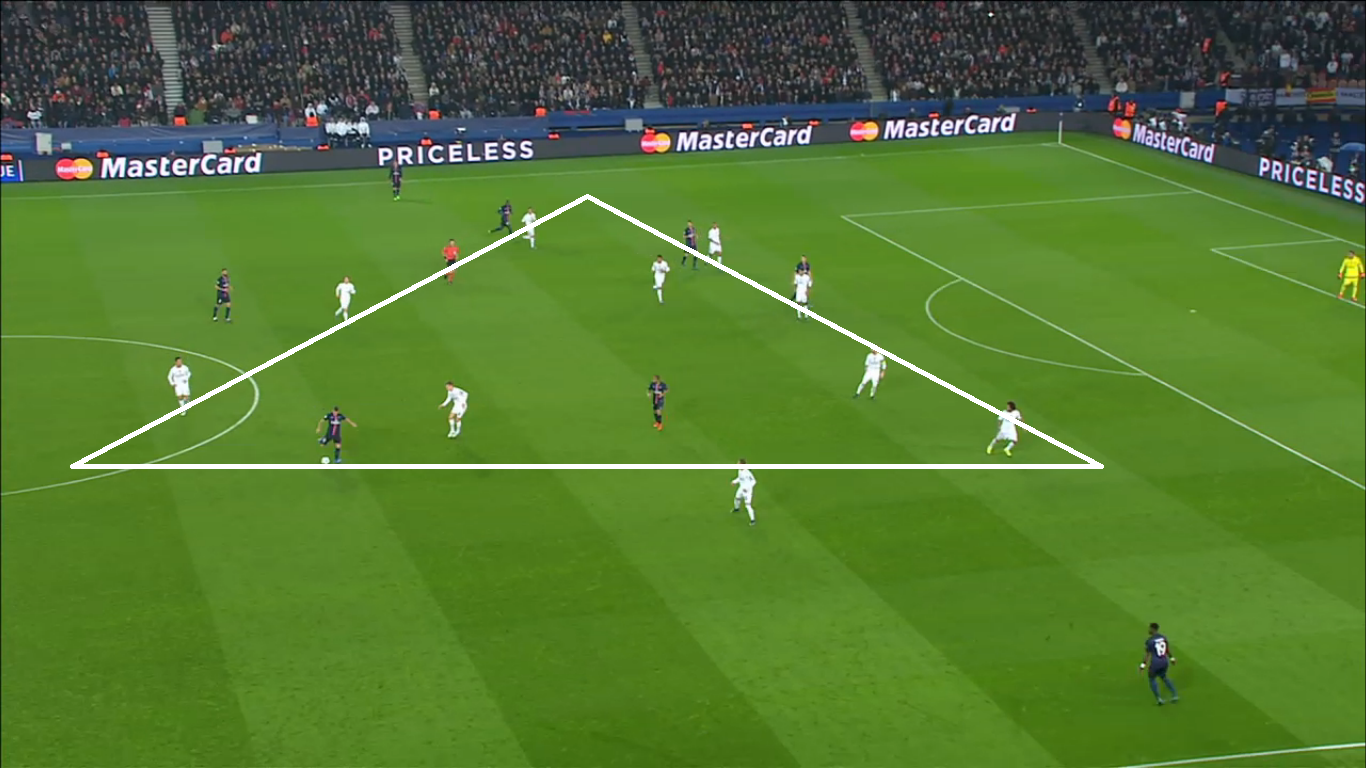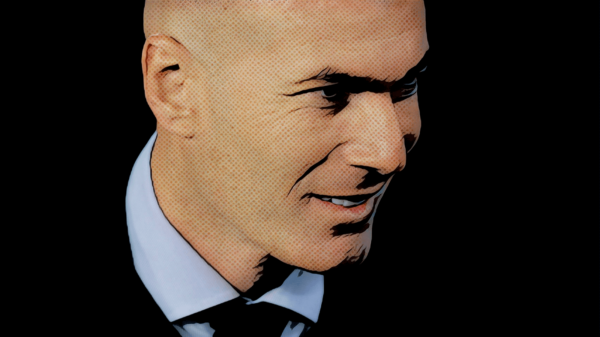Eric Devin tactically analyses the 0-0 stalemate between giants, PSG & Real Madrid.
Traditionally, one would never expect a match between Real Madrid and Paris Saint-Germain to end scoreless. Symbolizing tradition and the concept of the nouveaux riches in European football, neither have been goal-shy over the past four seasons, and when the group stage draw was made for this year’s Champions’ League, the pair’s clashes on Matchdays 3 and 4 looked to be among the most tantalizing encounters. While some (though likely not readers of this site) would see a 0-0 scoreline and dismiss the match as having been dull and workmanlike, those who would will have missed out on a transcendent meeting between two sides hungry for European success. Neither did anything on the night to dim their chances of progression from this stage, nor to place any doubts about their capability to contend for the title, but since the two sides approached the match in very different ways, a reading of just how they went about their business becomes instructive.
With the likes of Karim Benzema, Gareth Bale and James Rodriguez unavailable and Luka Modric and Sergio Ramos at less than full strength, Rafa Benitez was always going to set Real Madrid up to play defensively. With a loss the only potentially discouraging (albeit not disastrous) outcome, playing for a draw on the road against the side that had always figured as their only real rivals for topping the group, that is precisely what the Spaniard did, to great effect. Paris Saint-Germain, for their part, were free of injuries save David Luiz and were eager to make a statement of intent. Playing at home against one of Europe’s traditional powers at a time when their opponents seemed ripe for the picking, having endured some mixed results in La Liga and struggling with injuries, this seemed the perfect opportunity to declare themselves European contenders. A victory on the night, even against a Real Madrid side that was clearly understrength, would go a long way towards showing the rest of Europe that four years into the QSI era, the hundreds of millions spent of transfer fees and wages were finally beginning to produce a team capable of competing at the very highest level. While Laurent Blanc and his charges fell a bit short of expectations in that regard on the night, they did do their part to make this ascintillating encounter.
Line Ups:

PSG: 16. Trapp; 19. Aurier, 2. Thiago Silva, 5. Marquinhos, 17. Maxwell; 8. Thiago Motta, 6. Verratti (Lavezzi, 79′), 14. Matuidi; 9. Cavani (Pastore, 66′), 11. Di Maria (Moura, 65)’, 10. Ibrahimovic.
Real Madrid: 1. Navas; 23. Danilo, 4. Sergio Ramos, 2. Varane, 12. Marcelo; 18. Vazquez, 8. Kroos, 14. Casemiro, 20. Jese (Cheryshev, 72′); 22. Isco (Modric, 68′), 7. C. Ronaldo.
PSG 0-0 Real Madrid
Real Limit the Danger
While Real Madrid have generally favored a 4-3-3 in recent years, with so many attacking players unavailable, Benitez opted to operate with a 4-4-1-1 formation. There had been some suggestion prior to the match that he might go with a 4-4-2, with Jese playing off of Ronaldo, but in the end, Isco slotted in behind the Portuguese, playing quite a bit deeper so that the overall effect was closer to a 4-5-1 at times. Not only would this formation aid in pressing Paris Saint-Germain high up the pitch, but it would have the added benefit of relieving Ronaldo of many of his defensive duties. Rather than having to contend with the likes of Serge Aurier or Blaise Matuidi, his role in this instance was merely to provide token pressure on PSG’s center backs, while acting as deep-lying striker when Real were in possession, allowing Jese, Isco and the right winger, Lucas Vazquez to run onto the ball as it was played along the ground. Indeed, it was this gambit that produced arguably the match’s best chance, as Kevin Trapp had to be quick off his line to deny Jese midway through the second half.

Matuidi caught in possession
Further back, Toni Kroos and Casemiro anchored the midfield, with the pair switching off in leading an aggressive pressing game, seeking to pinch PSG centrally. Thiago Motta was generally up for the task, but on more than one occasion, his midfield partners, Marco Verratti and Blaise Matuidi were caught in possession, with one early instance leading to a booking for the Frenchman as he was stripped of the ball by Casemiro, only to clumsily foul the Brazilian in attempting to rectify his mistake While Matuidi did have some joy in wide areas ahead of Maxwell later in the match, delivering a handful of fine crosses, his usual involvement with the ball at his feet was severely limited, introducing a level of predictability for the hosts as they sought to spring Angel Di Maria with long balls.

Cavani in space
Across the defensive line, Danilo was an assured presence at right back, playing much more narrowly than his opposite number, Aurier. While the Ivorian had to be mindful of the rampaging Marcelo down his flank, the former Porto player had to contend with only Edinson Cavani. While Cavani can be a lovely player, as his time at Napoli demonstrated, and he is rarely short of effort, his ability to be an effective wide player in a 4-3-3 is hampered by his lack of pace. With any pass to the Uruguayan likely to be a diagonal ball from Motta or Di Maria, Real Madrid were able to sag off the big man, allowing Danilo to be almost an auxiliary central defender. With Isco dropping deep to harry Motta, Real were thus easily granted a numerical advantage in midfield, allowing them to double players on the ball or cut off passing routes much more efficiently.
In the above diagram, Matuidi is tightly marked by Vazquez, who can move inside without fear of Cavani on the wing, as Isco comes back to pressure Motta. Ibrahimovic is being defended with looser pressure by Kroos and Casemiro, allowing both Marcelo and Jese to track a potential run by Di Maria, indicated by the arrow. With the advantage of the Argentine’s pace limited and the full backs hanging back, wary of Real’s danger on the counter, the system worked to a tee for the majority of the match, as PSG were generally limited to hitting long balls for Di Maria to chase.

Attempted PSG Break
Even when the hosts were able to dispossess their opponents, (most often Marcelo) this same imbalance saw their counterattacks similarly frustrated. In this example, Marcelo, who is out of the frame, has lost the ball, as he generally will do several times in a match. However, because Cavani and Ibrahimovic are so slow, Di Maria, who has the ball with only Kroos to beat (moving in the direction of the arrow), has little in the way of options. While certainly a fast player, it is unlikely that the Argentine would be able to beat Kroos and Sergio Ramos, (in the circle) who is also tracking his run. Here, he maintains possession of the ball, but by the time Cavani or Ibrahimovic are in position to receive a pass, Marcelo and Jese have recovered and his task is considerably tougher.

Verratti on Kroos in the second half
PSG’ Pressing: Modric Makes the Difference
This isn’t to say that Real were immune to their own medicine. Particularly in the second half, PSG were also eager to press, and caused several moments of nerves for the visitors. While the French side could rely on Thiago Motta at the base of midfield to bail them out with his assured passing, Real, especially prior to the introduction of Luka Modric lacked that sort of player, as Kroos and Casemiro, for all of their energy are somewhat less adept with the ball at their feet. From the beginning of the second half PSG attempted to exploit this weakness more directly, using Verratti and Matuidi to pressure the pair when they were attempting to move play upfield. With Marcelo often operating in a more attacking position than Kroos, this meant that the German at times lacked an easy pass to get himself out of trouble, and was forced into playing the ball out of touch or lumping it long.

Thiago Motta pressing
Thiago Motta often took this one step further, chasing the ball all the way back to the center backs. In this example he chases after Sergio Ramos (white circle) as Ibrahimovic seeks to cut off Varane as a passing option. While this tactic is often effective against center backs, even ones of the class of Ramos and Varane, the issue in the example is how it works to PSG’s benefit in a tangible way. There is the obvious hope that if Motta can dispossess Ramos, he can play a ball along the ground for Ibrahimovic to chase, but the likelihood that the Swede could beat his marker, Varane for pace is next to nil. Di Maria and, to a lesser extent, Cavani are certainly quicker players than Ibrahimovic in terms of being potential targets, but as indicated by their positions (yellow ovals) don’t quite seem to be at the races. Thus, while giving Real, a side already uncomfortable in possession, a dose of their own medicine would appear to be an intelligent solution to the problem, pressing requires the participation of the entire team to be successful. If the wide players in this example aren’t attuned to the actions of the midfield three, it is unlikely the pressure, no matter how skillfully applied, will result in any measure of success.

Real shaped 4-2-3-1
However, Benitez was fairly quick to realize the potential dangers of this new aggression on the part of PSG, and quickly introduced Luka Modric for Isco. The Croatian was coming off a long spell on the sidelines, but once introduced, was the palliative that La Real needed. With Isco coming off, Real shifted to a 4-2-3-1 in defense, with Jese and Vazquez tucked just a bit more narrowly, Modric between them. This would have the effect of opening more passing lanes for Kroos and Casemiro, who became a midfield two. Introduced with only twenty-odd minutes to play, Modric was full of energy and put on a superb passing display; despite his teammates spurning their chances, his introduction saw Real once again in the ascendancy, underscoring the value of his versatility and in-game intelligence.
Blanc Rolls the Dice
Before Modric had been introduced, however, PSG had made their own shift. Even as the hosts seemed to be gaining ground, Real’s nerves showing as PSG ratcheted up their press, Cavani and Di Maria continued to cut isolated figures. The Uruguayan had a stunning chance ten minutes after the interval, but with Ibrahimovic continuing to play in his familiar withdrawn role, even as he tried to drift inside from the left, Maxwell pushing up in support, his impact was still limited, the athleticism of Ramos and Varane being too much to overcome. On the other flank, Di Maria had barely sniffed the ball in the second half, aside from a deflected shot that was easily claimed by Navas. When both were removed on 67 minutes, it was no surprise, nor was the identity of their replacements, Lucas Moura and Javier Pastore.
The pair of South Americans, so influential down the stretch as PSG overcame first Marseille and then Lyon to capture the title, have been the odd men out since the arrival of Di Maria, despite having been easily the club’s most potent creative forces last season. Their introduction, despite being necessary owing to the unevenness on display from Cavani and Di Maria, however, only served to muddy the waters. Moura nominally was positioned on the right and Pastore on the left, but both seemed a little confused as to their roles. For Pastore, it seemed at times as if he had moved in for Matuidi, with the Frenchman playing wide on the left. Lucas, meanwhile, continually took a central role.

Madrid’s compact triangle
In the above image, Marco Verratti is readying a pass into the right flat for Aurier. On the opposite flank, Maxwell is in a bit of space as well. The space that both fullbacks seem to be enjoying, however, was all that Real seemed like conceding. If Benitez’s squad had seemed like being compact in the first half, the introduction of Modric only furthered the effect; all ten outfield players occupy a very narrow part of the pitch, but in doing so, they force PSG to play the ball wide. Thus, even though two dangerous creative players have been introduced to the game, by packing the area in front of the penalty area, their task is made quite difficult. With Cavani out of the game, Real are happy to allow the likes of Matuidi and the fullbacks to bang crosses into the box, confident as they are in the aerial ability of Varane and Ramos.
Blanc’s final substitution was borne more out of necessity than any tactical reshuffling, as Marco Verratti was continuing to act impetuously, even after having already been booked. With the diminutive Italian replaced by Ezequiel Lavezzi, Paris essentially lost their shape and the match drew to a rather dour conclusion after a fairly exciting first eighty minutes. Even with that having been the case, this match was truly a spectacle for the tactically inclined. Despite the pejorative language that has been thrown Benitez’s way during his career, the way that he not only inspired a total team effort in defense but was also able to recognize and counter so ably when Blanc upped the ante through his own pressing, the Spaniard delivered a performance for the ages on the evening. The relatively unheralded trio of Vazquez, Casemiro and Jese worked hard all match, and even Ronaldo put in a bit of a shift defensively, the team recognizing the potential value of not only a point but of overcoming adversity. For that, Benitez deserves, at last, some credit.
Written by Eric Devin


























































